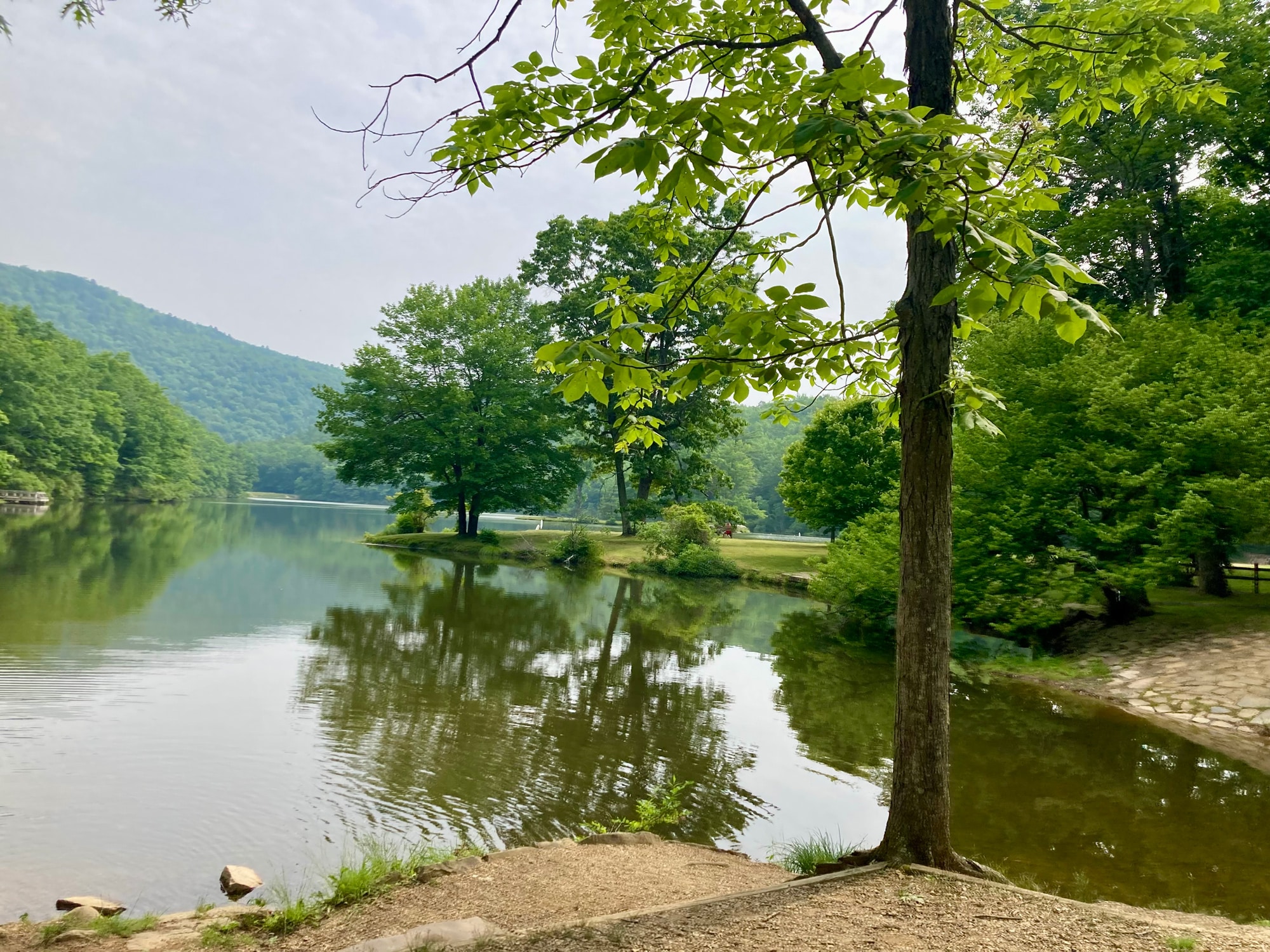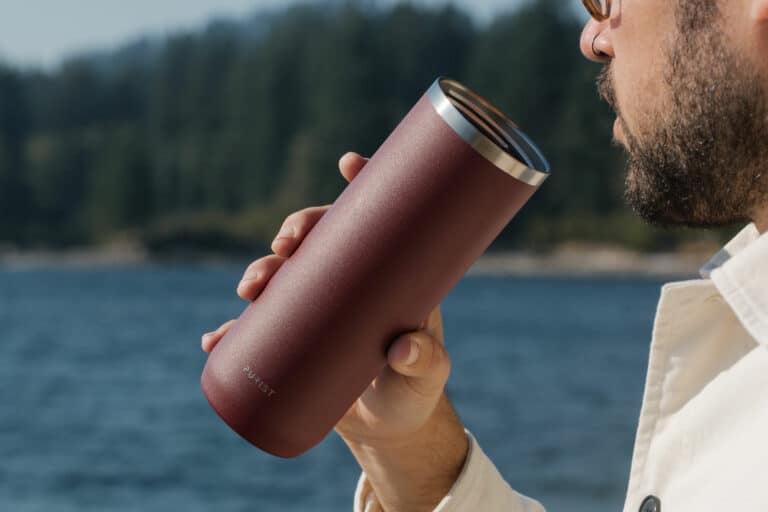To these incredibly scenic lakeside camping spots in the Blue Ridge
Lake Trips are summer classics. Maybe it’s the sunrise paddling announced by belted kingfishers, lazy afternoons spent floating in a tube (cold drink in hand, of course), and evenings spent casting for brawny bass. Or maybe it’s all those lingering technicolor sunsets. Luckily, in the Blue Ridge region we have big bodies of water to make your own lasting memories. Here are some of the best places to snag a lakeside campsite during the vacation months.
Lake James State Park, North Carolina
Nestled along massive 6,510-acre Lake James in western North Carolina, about 50 miles northeast of Asheville, Lake James State Park offers a variety of waterfront camping options. Divided into two different access areas, Paddy’s Creek and Catawba River, the state park features both hike-in and paddle-up campsites along the lake’s 50 miles of shoreline.
In the Catawba River portion of the park, the hike-in campground offers more than a dozen spots spread along the lakeshore, accessible from the Lake Channel Overlook Trail. For paddlers, the park’s Long Arm Peninsula is peppered with 30 waterfront campsites, divided into three separate camping areas. And for the devoted car campers, Paddy’s Creek area also offers drive-up campsites, although none located directly on the lakeshore.
The park has a lot to offer on dry land too, including 30-plus miles of trails, with more than 15 miles open to mountain bikers. And the Pisgah National Forest’s Linville Gorge Wilderness is located about 20 miles north of the state park. Of course, it’s hard to leave the water; the cinematic lake famously served as the backdrop for the 1992 film The Last of the Mohicans.

Lake Moomaw, Virginia
Nestled into a natural gorge, Lake Moomaw is among the largest lakes in the George Washington National Forest. Fed by the Jackson River, the lake spreads over more than 2,530 acres, with more than 40 miles of shoreline and plenty of real estate for campers. The lake is deep, too, sinking to depths of more than 125 feet, meaning there’s enough chilly water to harbor populations of brown, rainbow, and brook trout, along with largemouth bass, bluegill, and channel catfish.
To score a spot beside the water, head for the Bolar Mountain Recreation Area, spread along the northern end of the lake near the town of Hot Springs. All three of the recreation area’s campground loops offer a handful of spots along the lake, and on dry land, there are more than 10 miles of trails to explore. For a little more seclusion, there’s the Greenwood Point Campground. Located on a peninsula jutting into the lake, the campground is only accessible on foot or by boat. Paddlers can launch from the Fortney Branch Boat Launch, while for hikers it’s a 3.2-mile trek along the Greenwood Point Trail, beginning in the Bolar Mountain Campground.

Julian Price Campground, North Carolina
Waterside campsite right smack dab in the middle of the Blue Ridge Parkway? North Carolina’s Julian Price Campground is too good to be true. Located about five miles from Blowing Rock, the campground is nestled along the shoreline of 48-acre Price Lake, spread in the shadow of Grandfather Mountain (to get a spot right beside the water, head for Campground Loop A). The rhododendron-tufted lake is the centerpiece of Julian Price Memorial Park, a 4,200-acre retreat created by insurance magnate and philanthropist Julian Price, with land he began purchasing in the 1930s. When Price died unexpectedly in a car accident in 1946, the acreage was donated to the Blue Ridge Parkway. To get the lay of the land, the 2.7-mile Price Lake Trail circles the entire lake, serving up plenty of perfect sunrise spots. For a longer haul, the campground’s trail network also connects to the Boone Fork Trail, a 4.8-mile loop that meanders past Hebron Falls, and the longer Tanawha Trail, extending for 13.5 miles from Julian Price Memorial Park to Beacon Heights, along the flanks of Grandfather Mountain.

North Bend Park, Virginia
Huddled along the 50,000-acre Kerr Reservoir, North Bend Park has plenty of shoreline. Managed by the Army Corps of Engineers, the park is the biggest on the lake and offers more than 240 campsites, divided into four separate waterside loops, perfect for parking a stand-up paddleboard, and, with largemouth bass, channel catfish, and striped bass lurking in the water, there are plenty of reasons to pick a spot right on the lake. Fed by the Roanoke River, the massive reservoir is also cradled by more than 800 miles of wooded shoreline, including three dozen different Wildlife Management Areas. The 32-mile High Bridge Trail, a historic rail-trail (and also a Virginia State Park) is also just a short drive from the campground and there are multiple access points between the towns of Pamplin and Burkeville.
Little Oak Campground, Tennessee
Nestled into a leafy cove in the southeastern corner of South Holston Lake in the Cherokee National Forest, about 25 miles from Bristol, the Little Oak Campground is a slice of scenic seclusion. Spread over a nubby peninsula, all four of the campground’s loops offer spots on the water, ideal for spotting green heron, belted kingfishers, and ruby-throated hummingbirds. For a taste of the national forest, the Little Oak Mountain Trail, a 1.5-mile loop, serves up views of South Holston Lake from the crest of Little Oak Mountain and is accessible from the campground. And about 30 miles away in the town of Abingdon, there’s the Virginia Creeper Trail. A 34-mile rail-trail extending from Abingdon to Whitetop Station, the trail traverses a swath of the Jefferson National Forest that’s threaded with trout streams.

Summersville Lake, West Virginia
Not far from the adventure hub of Fayetteville, Summersville is a scenic Southern gem with clear blue water surrounded by craggy cliffs. Kayakers and paddleboarders have much to explore in the lake’s 2,700 acres of water, and there are sweet spots to camp along 60 miles of shoreline. Mountain Lake Campground and Cabins has more than 250 sites, along with a swimming beach and access to lakeside hiking trails.
All photos by the author.








